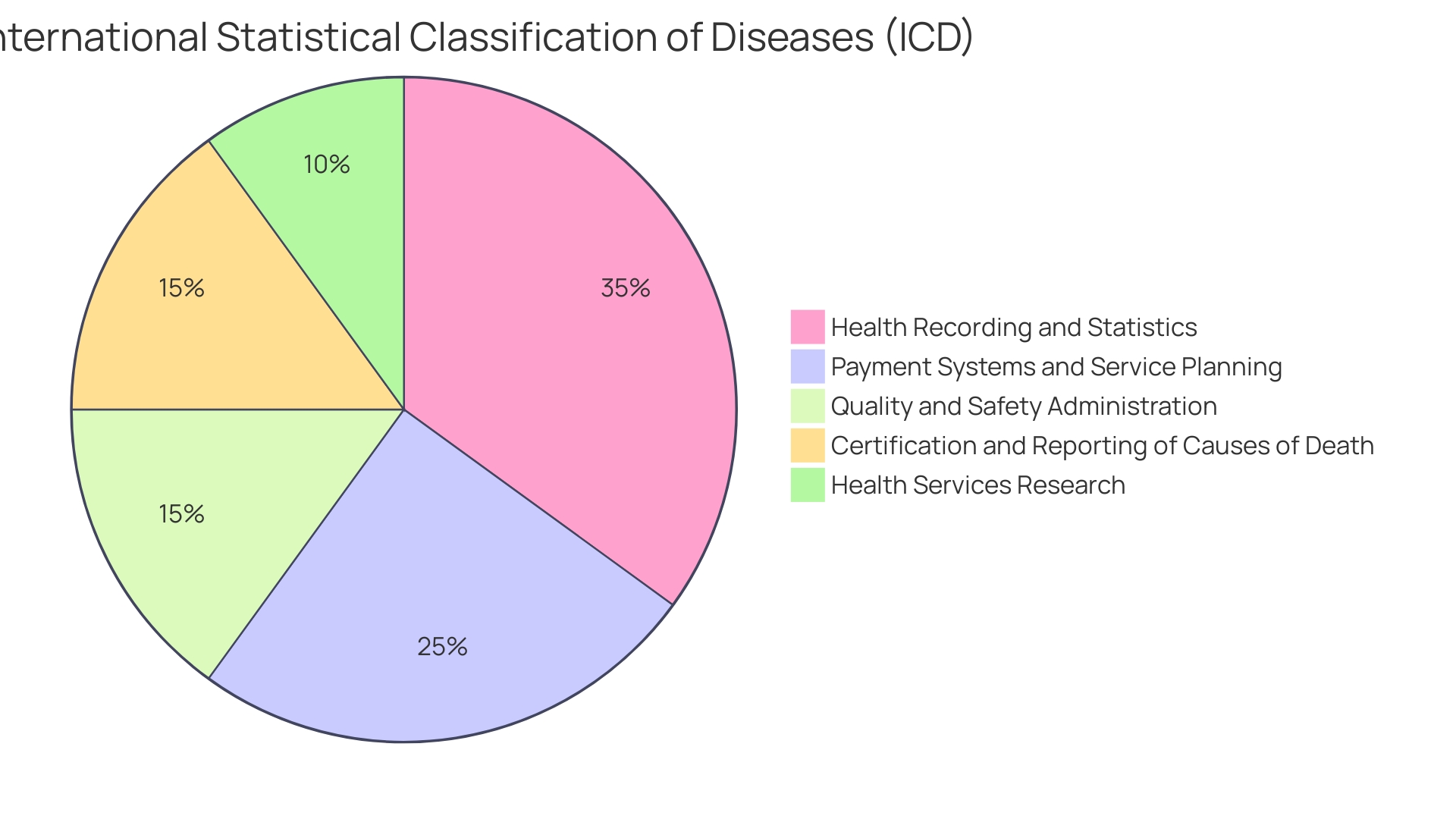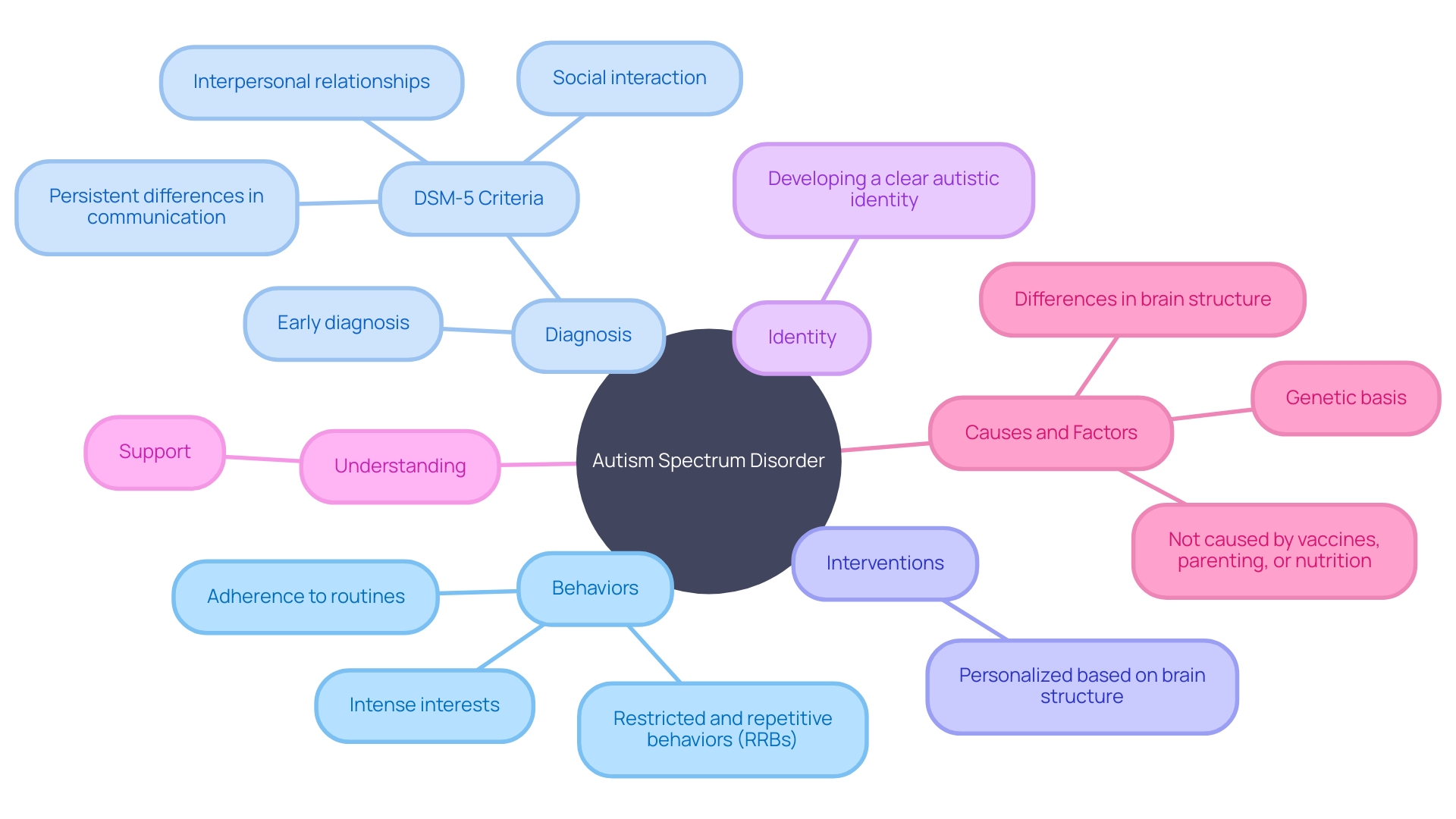Introduction
Autism Spectrum Disorder (ASD) is a complex neurodevelopmental condition that affects individuals in unique ways, influencing their social interactions, communication skills, and overall perception of the world. With early recognition and diagnosis, tailored interventions can significantly improve the quality of life for individuals with ASD. However, identifying signs of ASD in adults can be challenging, as many have lived without a diagnosis, attributing their experiences to other causes.
Additionally, ASD is characterized by a range of social communication difficulties, which can profoundly impact an individual's ability to interact effectively. Recognizing these challenges is the first step in providing the necessary support for effective communication and interaction. Moreover, ASD involves restricted and repetitive behaviors (RRBs), which can provide comfort and order in a world that may seem unpredictable.
While these behaviors can serve a purpose, they can also hinder daily life. Understanding and addressing RRBs is essential for creating inclusive environments and improving the quality of life for individuals with ASD. By fostering empathy, scientific rigor, and evidence-based practices, we can ensure that individuals with ASD and their families receive the support they need to thrive.
What is Autism Spectrum Disorder (ASD)?
Autism Spectrum Disorder (ASD) is a complex neurodevelopmental condition that manifests in a multitude of ways, influencing how people interact socially, communicate with others, and experience the world around them. The variety of symptoms across individuals with ASD implies that each person's experience is unique, with varying levels of severity and impact on daily existence.
From childhood through adulthood, ASD's core characteristics—persistent difficulties in social communication and interaction, along with restrictive and repetitive behaviors—remain consistent, though they may evolve over time. Early identification and diagnosis are vital, as they open the door for personalized interventions that can greatly enhance the quality of living.
The latest research underscores the need for nuanced understanding and approaches to ASD diagnosis. The ICD-11, for instance, proposes a broader range of potential features for ASD diagnosis, some of which may not be immediately observable. This shift from a strictly medical model to a more inclusive social model recognizes ASD as a spectrum of internal experiences as well as external behaviors, although it raises questions about clinical utility and differentiation from other conditions.
Recognizing signs of ASD in adults is particularly challenging, as many have lived without a diagnosis, attributing their experiences to other causes. Adults may display signs such as difficulties in social situations, adherence to routines, and heightened or reduced sensitivity to sensory input—echoes of the childhood hallmarks of the disorder.
As we continue to learn more about ASD, the importance of viewing it as a spectrum becomes clear. With an estimated 1 in 36 people affected, according to the CDC, awareness and education are crucial. By understanding ASD's manifestations and supporting those affected, we can ensure that everyone has the opportunity to lead a fulfilling life.
It is essential to note that while we strive to provide accurate and helpful information, any medical concerns should be discussed with a healthcare professional. Our intent is to foster informed conversations, not to offer medical advice.

Early Biological Risk Factors and Developmental Precursors
A confluence of biological factors, spanning genetics to environmental exposures, is believed to influence the development of Autism Spectrum Disorder (ASD). Genetic predisposition acts as a significant cornerstone in this matrix of risk factors, with research indicating that the heritability of autism is substantial. This genetic vulnerability may interact with a variety of prenatal and perinatal factors, such as complications during birth or maternal health issues, which can further affect developmental trajectories. Environmental factors, including exposure to certain substances or nutritional deficiencies during critical periods of brain development, also play a role in the emergence of ASD characteristics.
Early identification of ASD is crucial for the timely implementation of interventions that can profoundly impact a child's development. Screening practices, such as the Modified Checklist for Autism in Toddlers-Revised with Follow-Up (M-CHAT-R/F), are utilized during well-child visits to detect signs of autism. Despite its utility, the M-CHAT-R/F has been noted to perform variably outside of controlled research settings. A significant study involving over 25,000 children in primary care highlighted the need for more accurate and universally applicable screening methods; the M-CHAT-R/F demonstrated high specificity (95.0%) but low sensitivity (39.0%), and a positive predictive value of 14.6%.
These findings underscore the importance of refining autism screening tools to enhance their precision and efficacy, particularly for diverse populations that may currently be underserved. Advancements in this field show potential for decreasing disparities in early diagnosis and access to interventions, which are recognized to enhance long-term results for people with ASD. It is the interplay of genetic and environmental factors, observed through rigorous, ethically conducted research, that guides our evolving understanding of ASD and how best to support those affected.
Social and Communication Symptoms
Autism Spectrum Disorder (ASD) is characterized by a range of social communication difficulties, which can profoundly impact a person's ability to interact with the world around them. For some, this means grappling with the subtleties of body language and facial expressions, which can be hard to interpret and respond to appropriately. Others may face challenges with language development, varying from delays in speaking to complete absence of speech. The importance of recognizing these challenges cannot be overstated, as it is the first step in providing the tailored support needed for effective communication and interaction.
Research underscores the complexity of these communication barriers, revealing that they can also lead to deeper issues such as depression, particularly in adolescents with autism. It has been observed that mood disorders in people with autism can manifest in various ways, including through behavioral challenges and social withdrawal. Current studies aim to improve our understanding of these links to better support the mental health of those on the autism spectrum.
Furthermore, it is now acknowledged that people with autism often develop compensatory strategies to navigate a society that isn't structured to accommodate their needs. These strategies can involve both conscious and unconscious efforts to blend in with typical behaviors, highlighting the resilience and adaptability of people with autism. However, these efforts can also conceal the real challenges faced by autistic people, making it vital for support systems to acknowledge and tackle the underlying difficulties.
Through a commitment to evidence-based practices and a deep understanding of the lived experiences of those with autism, we can create more inclusive and supportive environments. This includes recognizing the potential for adverse effects and conflicts of interest in intervention research, ensuring that the outcomes being measured are genuinely beneficial for the autistic community. It is through this lens of empathy and scientific rigor that we can hope to enhance the quality of existence for those with ASD and their families.
Restricted, Repetitive Patterns of Behaviors, Interests, and Activities
Autism Spectrum Disorder (ASD) involves a range of behaviors and is often described as a 'spectrum' because of the way it affects individuals differently and to varying degrees. One of the hallmarks of ASD is the presence of restricted and repetitive behaviors (RRBs), which encompass a variety of actions and rituals. Individuals with ASD may exhibit repetitive movements, develop intense and specialized interests, and adhere to strict routines. These behaviors are not just quirks; they can serve a purpose for those with ASD by providing comfort and a sense of order in a world that can seem unpredictable.
RRBs can, however, sometimes hinder daily existence, making it essential to understand and address them adequately. Research has shown that RRBs have a developmental role, aiding in neural growth and voluntary control during early childhood. When these behaviors persist past certain developmental periods, they may indicate an underlying neurodevelopmental condition like ASD. It's important to recognize that while speech is commonly associated with communication, it's not the sole expression of language. People with ASD may communicate their interests and understand complex concepts, even if they do not speak traditionally. This understanding can lead to better support strategies, allowing those with ASD to expand their activities and integrate into various aspects, including educational and career opportunities that play to their strengths.
Recent advances in science, such as the genetics-first approach and novel techniques like transport-based morphometry (TBM), have been shedding light on the link between brain structure and ASD. These methods have revealed patterns in brain morphology associated with genetic variations known to correlate with ASD, paving the way for more personalized interventions. This research supports the significance of early diagnosis and customized assistance to aid individuals with ASD navigate their experiences with greater ease and success.
For adolescents and young adults, especially, developing a clear understanding of one's identity, which may include their autistic identity, is crucial. This sense of self informs life choices and promotes a sense of community belonging. By means of community-driven initiatives such as the program provided by Friends of St James Park in Southampton, people with ASD have the chance to participate in meaningful activities that promote abilities, connections, and a feeling of accomplishment.
Understanding and supporting individuals with ASD requires compassion, knowledge, and a commitment to fostering environments where they can thrive. By recognizing the significance of RRBs and offering suitable resources and strategies, we can help those with ASD lead fulfilling lives and make valuable contributions to society.

Conclusion
In conclusion, early recognition and diagnosis of Autism Spectrum Disorder (ASD) are crucial for tailored interventions that significantly improve individuals' quality of life. Identifying signs of ASD in adults can be challenging, but understanding the challenges posed by social communication difficulties and addressing restricted and repetitive behaviors (RRBs) is essential for creating inclusive environments.
By fostering empathy, scientific rigor, and evidence-based practices, we can ensure individuals with ASD and their families receive the support they need to thrive. Increasing awareness and education about ASD, viewing it as a spectrum, and refining screening tools for early identification are vital steps towards improving long-term outcomes.
Understanding the complexity of social communication difficulties and the impact of RRBs helps provide tailored support for effective interaction and daily life. Advances in scientific research, such as the genetics-first approach and innovative techniques like transport-based morphometry (TBM), offer promising avenues for personalized interventions.
By recognizing the challenges faced by individuals with ASD and offering suitable resources and strategies, we can help them lead fulfilling lives and make valuable contributions to society. Creating inclusive and supportive environments requires compassion, knowledge, and a commitment to empowering individuals with ASD.
In conclusion, by fostering understanding, support, and inclusivity, we can ensure the well-being and success of individuals with ASD and their families. Together, we can make a positive impact and ensure that everyone has the opportunity to thrive.




